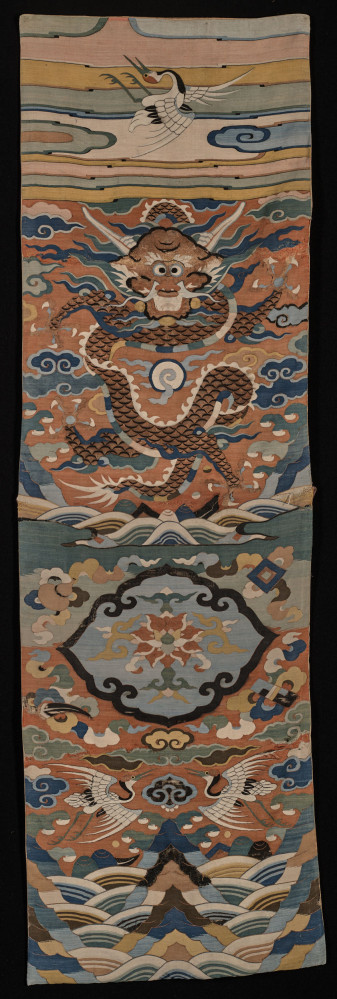
Tapesty
18th century
Castle Museum in Łańcut
Part of the collection: Orient
Tapestry – a throne covering. It was woven by hand using a technique called K’o-ssu. It is decorated with strongly geometric motifs of a crane against a background of colourful clouds (at the top), a golden dragon, a stylised lotus surrounded by Buddhist symbols – the Eight Precious Things. The lower part shows stylised waves, islands of Immortals and two cranes. These motifs are arranged with silk threads, pasted one next to the other on paper. Fabric of silk threads and gold jap – a thread wrapped in wire, dating to the 18th century. The eight symbols are objects associated with important events in the life of Buddha Shakyamuni. They represent the eight qualities of the Buddha’s enlightened body. It is believed that offering them is particularly auspicious as it creates good omens for the future. They are usually offered together with the Eight Auspicious Substances and the Seven Royal Treasures. The eight symbols are: a white parasol, a conch shell, a treasure vase, a victory banner, a dharma wheel, a pair of golden fish, an endless knot, and a lotus flower (four per each tapestry).
Author / creator
Dimensions
height: 50 cm, width: 41 cm
Object type
Orient
Technique
embroidery
Material
wood, silk
Creation time / dating
Creation / finding place
Owner
Castle Museum in Łańcut
Identification number
Location / status

18th century
Castle Museum in Łańcut

4th quarter of the 18th century
Castle Museum in Łańcut

18th century
Castle Museum in Łańcut
DISCOVER this TOPIC
National Museum in Lublin
DISCOVER this PATH
Educational path